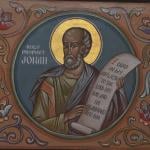Lipa, Philippines, Dec 28, 2016 / 02:49 pm (CNA).- The story of Sister Teresita Castillo and the supposed Marian apparitions of Lipa City, Philippines reads something like a mystery novel. A negative judgement given in a document signed by local bishops and subsequent suppression of the devotion most likely drove the visionary nun out of the convent. Years later, some bishops involved in the disapproval of the case allegedly came forward with deathbed confessions, saying they only ruled against the apparitions on threat of excommunication. A document from the 1950s that would further clarify the case is still being kept secret in the archives of the Vatican. Then in May of this year, the local Archbishop Ramon C. Arguelles announced that the Holy See had reiterated its negative judgement on the supernatural nature of the apparitions. The reiteration was a rebuttal to the archbishop, who had a few months prior announced (without Vatican approval) that the apparition had been reapproved as supernatural. The exchange was just the latest in a decades-long ping-pong match between the Vatican and the local clergy over whether or not the popular local devotion should be officially approved. As it currently stands, the apparitions of Mary in Lipa – known as Mary, Mediatrix of all Grace – are officially considered “not supernatural in nature” by the Holy See. The highest recognition that the Catholic Church gives to an alleged miracle is that it is “worthy of belief.” If investigations determine an event to be fraudulent or lacking in supernatural character, a rejection may be issued. Alternatively, the Church may declare that there is nothing contrary to the faith in a supposed miraculous phenomenon – but without making a determination on whether a supernatural character is present. However, in an unprecedented move in this case, the Lipa apparitions are not considered supernatural, but local devotion is still allowed. “I believe it to be the singular case in history where you have a negative judgement, but the devotion is allowed,” Michael O’Neill, a Catholic miracle researcher and author who runs the website miraclehunter.com, told CNA.Visions in gardens and rose petals from heaven This unique, mysterious and still-contentious case all began with a young nun in a quiet convent garden in 1948. Sr. Teresita, also known as Sr. Teresing, was just 21 years old when allegedly, Mary began appearing to her in the garden of her Carmelite convent in Lipa City. On September 12, 1948, the young nun was outside praying when one of the garden vines began to shake. She then heard the voice of the Virgin Mary, who asked Teresita to kiss the ground and return to the same spot for fifteen days. Sr. Teresita returned, and Mary reportedly appeared to her on a cloud, dressed in simple white robes with a small belt, hands clasped, and a golden Rosary hanging from her right hand. According to the visionary nun, throughout her 19 appearances that year, Mary stressed humility, penance, prayers for the clergy and the Pope, and to pray the Rosary. Teresita reported that there was one secret for herself, one for the Carmel convent in Lipa City, one for China, one for the entire world from the Blessed Mother. At her final appearance on November 12, 1948, Mary reportedly called herself by the title “Mediatrix of All Grace.” Also associated with the apparition are rose petals that seemed to fall from heaven, and appear to be emblazoned with images of Jesus, Mary and the Saints.The mysterious negative ruling Fast forward three years later, to 1951. Sr. Teresita left the convent sometime in 1950, likely because of all the controversy surrounding the apparitions. The local bishop, Alfredo Verzosa y Florentin, had approved the veneration of Our Lady, Mediatrix of All Grace, and the devotion easily grew in popularity in the already-Marian spirituality of the Filipino faithful. Despite the approval from the local bishop, a committee of Church hierarchy in the Philippines declared on April 11, 1951, that “there was no supernatural intervention in the reported extraordinary happenings including the shower of rose petals in Lipa.” The statement also contained the contentious phrase “until final decision on the matter will come from the Holy See”. Bishop Rufino Santos, who became apostolic administrator after the decision, ordered that no petals be given to anyone by the Lipa Carmelite community; and that the statue of Our Lady, Mediatrix be withdrawn from public view. Veneration of Our Lady, Mediatrix of All Grace remained officially disallowed for decades after the judgement of the committee, until February of 1990. On February 11, 1990, the nephew of Bishop Cesar M. Guerrero, one of the signers of the 1951 negative judgment, swore in an affidavit that his uncle signed the document under duress and was a believer in the authenticity of the apparitions, according to a book about the Lipa apparitions by June Keithley. The Catholic Bishops Conference in the Philippines did not respond by press time to requests for comment on the matter.Local devotion grows Later that year, a sister at the Lipa Carmel convent requested on her deathbed that the statue of Mary, Mediatrix of All Grace be brought back for veneration. The community obliged, and the statue was displayed in the convent chapel the next day. Soon after, Msgr. Mariano Gaviola, Archbishop of Lipa at the time, lifted the ban from Bishop Rufino Santos and allowed the statue to be displayed. In 2005, Most Reverend Ramon C. Arguelles, the new and still-current Archbishop of Lima, kicked off a campaign to further spread devotion and to place a statue of the Mediatrix of All Grace in parishes throughout the country, and publicly professed his personal devotion and belief in the apparition on numerous occasions.The ping-pong match continues Archbishop Arguelles felt so passionately about the devotion that on Nov. 12, 2009, on the 61st anniversary of Mary’s alleged final appearance to Sister Teresita, he officially lifted the 1951 ban on public veneration of the image, and formed a new commission to re-examine the apparition and related phenomena. Once again, about a year later, the Vatican shut it down. “We, the undersigned Archbishops and bishops, constituting for the purpose a special Commission, having attentively examined and reviewed the evidence and testimonies collected in the course of repeated, long and careful investigations, have reached the unanimous conclusion and hereby officially declare that the above mentioned evidence and testimonies exclude any supernatural intervention in the reported extraordinary happenings – including the shower of petals – at the Carmel of Lipa. This declaration is the official communication of the final decision on the matter, as approved by the Holy See," the bishops said in a statement. But Archbishop Arguelles’ personal faith in the devotion did not budge. After declaring in another homily his personal devotion and belief in the apparitions, he released an official statement of approval of the apparitions on Sept. 12, 2015 declaring “that the events and apparition of 1948 also known as the Marian phenomenon in Lipa and its aftermath even in recent times do exhibit supernatural character and is worthy of belief.” Which brings the saga to this past Spring, when the archbishop once again had to revoke his statement of official approval of the supernatural nature of the apparitions. It’s likely the first time ever that the Vatican and a local bishop have had so much back and forth over a supposed apparition, O’Neill said. “This is completely historic that the archbishop flipped over a Vatican confirmation of a previous judgement, and historic that the Vatican has come back over and flipped back a statement of the local bishops; those two things have never happened before,” he said. What’s the problem? What makes the alleged apparitions and related phenomena – the rose petals – so contentious? O’Neill said that while it is not known for sure, there are a few reasons that the Holy See may be hesitant to declare the apparitions as supernatural. One of these reasons, he said, may be because Sr. Teresita’s first mystical experience was actually an encounter with the devil. “There has always been the question of whether the devil was disguised in further apparitions,” he said. Another issue could be the complexity of the various related phenomena surrounding the apparition, O’Neill said, including the shower of rose petals and a claim from several children who said they saw the statue come to life. “So when you look at this - do you approve the whole thing? Or do you approve just the apparitions? Or what’s true or what’s a hoax? It’s a little bit of confusing territory when you have to deal with these many different types of mystical phenomena,” O’Neill said. So many mysteries remain with this supposed apparition. Where are these affidavits of the supposed deathbed confessions of bishops who claim they were coerced into the negative judgement? How thoroughly did the original committee of bishops examine the case - and what led them to the negative judgement? Archbishop Arguelles, as well as the Catholic Bishops Conference of the Philippines, did not respond to requests for comment by press time. If the document surfaced that confirmed Pope Pius XII’s approval of the negative judgement in 1951, there would be no way to reopen the case. But such a document, if it does indeed exist in this case, would be in the archives of the Congregation of the Doctrine of the Faith, which only releases documents to the public, with few exceptions, once they are more than 80 years old. On a recent visit to Lipa, O’Neill said he was able to visit the convent where Sr. Teresita supposedly had visions of Mary. The sisters there, he said, remain privately devoted to Mary, Mediatrix of all Grace. Though they remain obedient to the Holy See, they, as well as many of the faithful, quietly hope the case could be reconsidered in the future. In a country with 33 canonically recognized icons of Mary, the country’s Marian devotion is “incredible,” O’Neill said. “So there’s a great amount of disappointment among the people of the Philippines who followed this devotion, but they remain obedient to the Holy See.”Update 6/22, 1:47 p.m.: A previous version of the story said a negative Vatican judgement drove Sr. Teresita out of the convent. The judgement instead was signed by local bishops, and subsequent suppression of the devotion likely led to her leaving. Also, the line: "This declaration is the official communication of the final decision on the matter, as approved by the Holy See" has been included to the bishops 2010 statement to show the Holy See's ruling. This article was originally published on CNA June 18, 2016. Read more















